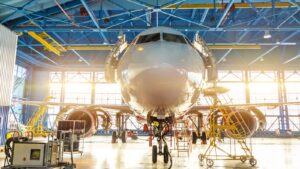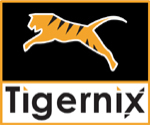Construction site accidents remain a major concern, with many workers facing life-threatening injuries each year! Despite advancements in safety protocols, the nature of construction work presents ongoing challenges. However, this is where the AI-powered wearables are changing the game. These wearable devices utilise artificial intelligence, or AI as many know it, to monitor workers’ health, track movements, and detect risks in real-time. With AI’s ability to provide immediate alerts to workers and supervisors, safety is being elevated to a new level, helping reduce the chances of accidents and improving worker well-being on construction sites.
In this article, we explore how AI-powered wearable technology enhances safety on construction sites.
In this article, we explore how AI-powered wearable technology enhances safety on construction sites.
What are AI-Powered Wearables?
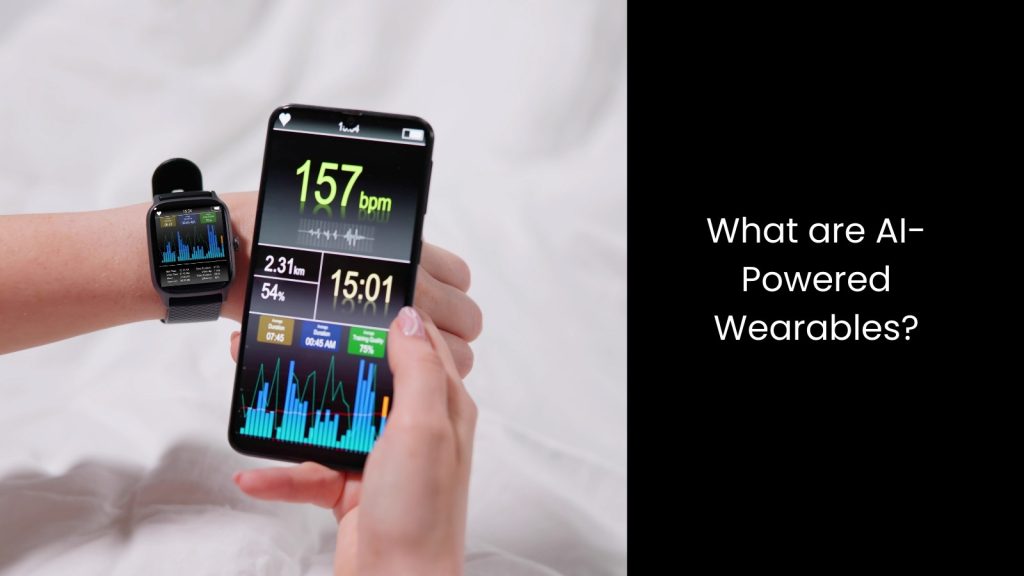
- These are smart devices worn on the body that use artificial intelligence to monitor, analyse, and respond to various conditions in real-time.
- The speciality of them is that they typically include sensors that track health metrics, movements, and environmental factors, while AI processes this data to detect patterns and make decisions. The popularity of AI-powered wearables in industries where safety is a concern, like construction, manufacturing, and healthcare, stems from their ability to reduce risks and provide instant feedback.
- In these fields, workers tend to face hazardous environments, and the wearables act as a continuous monitoring system. For example, construction workers can wear devices that detect signs of fatigue, monitor vital signs, or track their location on-site, ensuring they stay safe even in dangerous areas.
- So, the growing interest in AI-powered wearables can be attributed to their efficiency in providing real-time alerts and data analysis, which helps prevent accidents and improves overall safety.
Key Ways AI-Powered Wearables Enhance Construction Safety
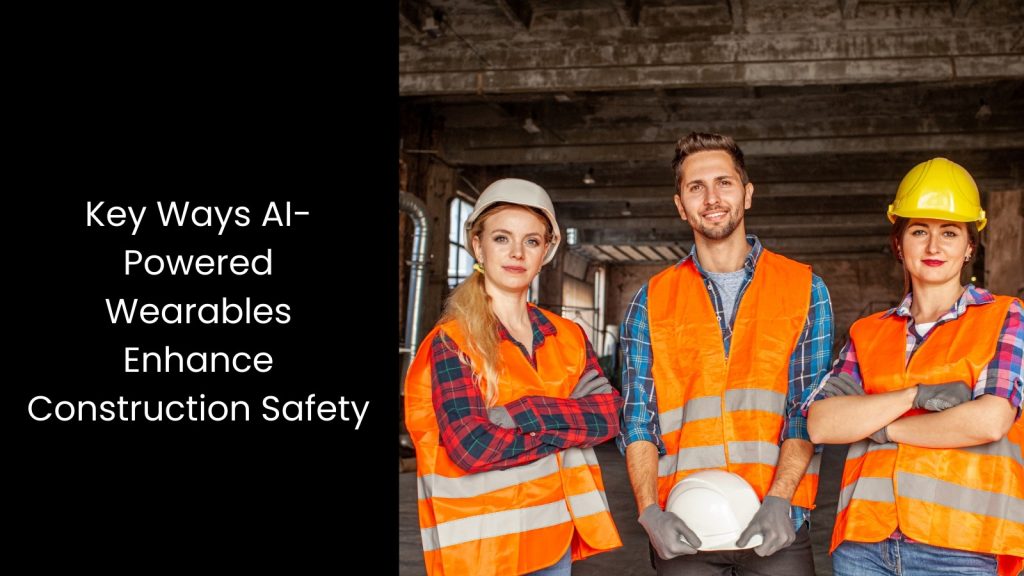
Geofencing for Safety Zones
AI-powered wearables help enhance safety as they use geofencing technology to create virtual safety zones around dangerous areas on the construction site.
These wearables are equipped with sensors that track workers’ real-time location and movement, enabling them to stay within safe boundaries. When workers approach or enter these predefined hazardous zones, the AI within the wearable instantly triggers an alert, warning both the worker and the site supervisor.
This feature is especially useful in environments with heavy machinery, high-risk operations, or unstable structures where even a small mistake can lead to serious injuries. The AI can also adjust these geofences based on real-time data, such as changing construction conditions or new risks on the site.
With AI-powered wearables, supervisors no longer need to monitor workers manually for safety violations; the system automatically detects potential dangers and provides immediate feedback.
These wearables not only help workers stay aware of their surroundings but also reduce the chances of human error. It offers a smarter approach to construction site safety.
These wearables are equipped with sensors that track workers’ real-time location and movement, enabling them to stay within safe boundaries. When workers approach or enter these predefined hazardous zones, the AI within the wearable instantly triggers an alert, warning both the worker and the site supervisor.
This feature is especially useful in environments with heavy machinery, high-risk operations, or unstable structures where even a small mistake can lead to serious injuries. The AI can also adjust these geofences based on real-time data, such as changing construction conditions or new risks on the site.
With AI-powered wearables, supervisors no longer need to monitor workers manually for safety violations; the system automatically detects potential dangers and provides immediate feedback.
These wearables not only help workers stay aware of their surroundings but also reduce the chances of human error. It offers a smarter approach to construction site safety.
Fall Detection
This significantly improves safety by incorporating fall detection technology, which helps protect workers from serious injuries. Let’s check it out further.
These wearables include advanced sensors that track a worker’s movement and body position. When a worker falls or experiences a sudden impact, the AI analyses the data from the sensors to quickly detect irregular movements.
This AI system then triggers an immediate alert, notifying supervisors or emergency teams in real-time. The speed of this alert is crucial because it ensures that help can be sent quickly to the scene, reducing the time between the fall and the response. For example, if a worker slips or falls from a height or trips over debris, the AI-powered wearable can instantly recognise the fall’s impact based on changes in motion patterns or pressure detected by the sensors.
This response can be vital in high-risk construction environments where falls often lead to severe injuries or even fatalities.
AI wearables can also be programmed to detect different types of falls, such as slow or fast falls, allowing for more accurate alerts. The ability of these devices to quickly notify emergency personnel or site supervisors also helps reduce the chance of delayed medical attention.
These wearables include advanced sensors that track a worker’s movement and body position. When a worker falls or experiences a sudden impact, the AI analyses the data from the sensors to quickly detect irregular movements.
This AI system then triggers an immediate alert, notifying supervisors or emergency teams in real-time. The speed of this alert is crucial because it ensures that help can be sent quickly to the scene, reducing the time between the fall and the response. For example, if a worker slips or falls from a height or trips over debris, the AI-powered wearable can instantly recognise the fall’s impact based on changes in motion patterns or pressure detected by the sensors.
This response can be vital in high-risk construction environments where falls often lead to severe injuries or even fatalities.
AI wearables can also be programmed to detect different types of falls, such as slow or fast falls, allowing for more accurate alerts. The ability of these devices to quickly notify emergency personnel or site supervisors also helps reduce the chance of delayed medical attention.
Real-Time Health Monitoring
This is certainly an advanced way to monitor workers’ health in real-time, which is especially important in physically demanding environments.
Its embedded sensors can track vital signs such as heart rate, body temperature, and blood oxygen levels, which can change due to physical strain, heat exposure, or other environmental factors. When the wearables detect abnormal readings, such as an unusually high heart rate or low oxygen levels, the AI system immediately alerts the worker and supervisors.
This helps prevent potential health risks, such as heatstroke or exhaustion, before they become more serious.
For example, if a worker’s body temperature rises too high in a hot environment, the AI-powered wearable can send a warning, allowing the worker to take a break or hydrate before experiencing a heat-related emergency. Similarly, if the heart rate or oxygen levels fall outside the normal range, the wearable can instantly notify supervisors, enabling them to act quickly.
Its embedded sensors can track vital signs such as heart rate, body temperature, and blood oxygen levels, which can change due to physical strain, heat exposure, or other environmental factors. When the wearables detect abnormal readings, such as an unusually high heart rate or low oxygen levels, the AI system immediately alerts the worker and supervisors.
This helps prevent potential health risks, such as heatstroke or exhaustion, before they become more serious.
For example, if a worker’s body temperature rises too high in a hot environment, the AI-powered wearable can send a warning, allowing the worker to take a break or hydrate before experiencing a heat-related emergency. Similarly, if the heart rate or oxygen levels fall outside the normal range, the wearable can instantly notify supervisors, enabling them to act quickly.
Gesture and Motion Analysis
These wearables have the potential to track the worker’s posture, motions, and body movements during tasks.
Then the AI systems analyse this data in real time to identify if a worker is performing movements that could lead to injuries, like lifting with improper posture or bending awkwardly. For example, when a worker lifts heavy equipment or materials, the AI can detect if the body mechanics are incorrect, such as bending the back instead of using the legs, which can lead to musculoskeletal injuries over time.
The AI-powered wearable then sends an alert to the worker, reminding them to adjust their technique, helping to prevent strains or other injuries. These wearables also analyse repetitive movements, which are common in construction jobs, and warn workers if they are performing actions that could cause wear and tear on their joints and muscles.
The good thing is that the latter technology not only tracks movement but also actively suggests better practices to reduce physical stress and injury risk.
Then the AI systems analyse this data in real time to identify if a worker is performing movements that could lead to injuries, like lifting with improper posture or bending awkwardly. For example, when a worker lifts heavy equipment or materials, the AI can detect if the body mechanics are incorrect, such as bending the back instead of using the legs, which can lead to musculoskeletal injuries over time.
The AI-powered wearable then sends an alert to the worker, reminding them to adjust their technique, helping to prevent strains or other injuries. These wearables also analyse repetitive movements, which are common in construction jobs, and warn workers if they are performing actions that could cause wear and tear on their joints and muscles.
The good thing is that the latter technology not only tracks movement but also actively suggests better practices to reduce physical stress and injury risk.
Voice-Activated Alerts
It has the power to incorporate voice-activated alerts that allow workers to stay hands-free while responding to potential risks.
These wearables are designed with built-in voice recognition technology, which can detect verbal commands or safety triggers from workers. When a worker speaks specific commands or warnings, such as ‘help’ or ‘danger’, the AI system instantly processes these requests and triggers appropriate safety measures.
For instance, if a worker is in a hazardous situation but cannot manually activate an alert, they can simply speak a command! Then the AI-powered wearable sends an immediate notification to supervisors or emergency teams. This feature is especially useful in environments where workers need to keep their hands free for handling equipment or performing tasks.
With voice recognition, workers can communicate safety concerns, report issues, or ask for assistance without having to stop what they are doing. In addition, the wearables can also use voice activation to trigger specific commands, such as turning on an emergency alert system or adjusting safety protocols on-site.
This hands-free capability ensures that workers can focus on their tasks while still being able to respond quickly and efficiently to any danger.
These wearables are designed with built-in voice recognition technology, which can detect verbal commands or safety triggers from workers. When a worker speaks specific commands or warnings, such as ‘help’ or ‘danger’, the AI system instantly processes these requests and triggers appropriate safety measures.
For instance, if a worker is in a hazardous situation but cannot manually activate an alert, they can simply speak a command! Then the AI-powered wearable sends an immediate notification to supervisors or emergency teams. This feature is especially useful in environments where workers need to keep their hands free for handling equipment or performing tasks.
With voice recognition, workers can communicate safety concerns, report issues, or ask for assistance without having to stop what they are doing. In addition, the wearables can also use voice activation to trigger specific commands, such as turning on an emergency alert system or adjusting safety protocols on-site.
This hands-free capability ensures that workers can focus on their tasks while still being able to respond quickly and efficiently to any danger.
Combining AI with Wearables for Maximum Construction Safety
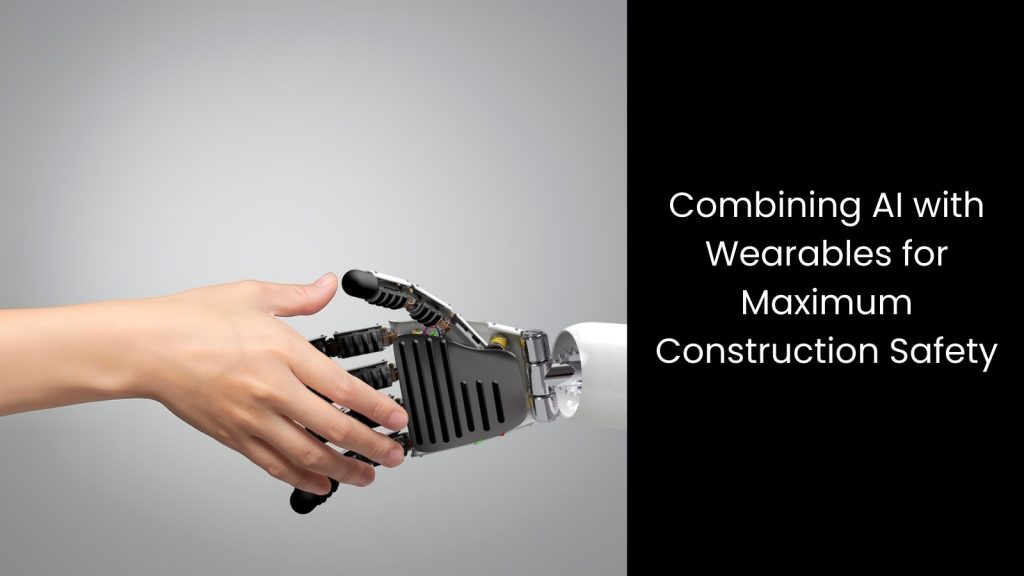
The fusion of AI and wearables in construction provides an innovative solution to enhance worker safety. With AI analysing data from wearables, construction sites can proactively address potential dangers. This technology not only reduces accidents but also creates a culture of continuous safety awareness, allowing workers and supervisors to stay ahead of risks and ensure a safer worksite.


